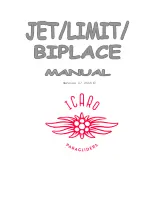
Wingspan:........................................65.in.(1651mm)
Wing.Area:..........................770.sq.in.(49.68.sq.dm)
Assembly mAnuAl
F6F Hellcat 60 ARF
Length:.............................................53.in.(1346mm)
..............Measured.with.Tru-Turn."A".Style.Spinner
Weight:.............................. .8–9.5.lb.(3.6.kg–4.3.kg)
Specifications
5.
Summary of Contents for F6F Hellcat 60 ARF
Page 43: ...43 Notes ...


































